In Praise of Plants
Select Format
Select Condition 
Book Overview
Francis Halle examines the human---and even scientific---bias toward animals at the expense of our understanding of plants. Readers will find their ideas about plants fundamentally altered and their... This description may be from another edition of this product.
Format:Hardcover
Language:English
ISBN:0881925500
ISBN13:9780881925500
Release Date:August 2002
Publisher:Timber Press (OR)
Length:334 Pages
Weight:0.45 lbs.
Dimensions:1.1" x 6.2" x 9.5"
Customer Reviews
1 rating
Technical but wondrously informative
Published by Thriftbooks.com User , 21 years ago
It's always a good sign to see that someone has bothered to translate a science book from another language into English. Publishers can usually get some English-language scientist to write a tome on the latest discoveries in a more commercially agreeable manner than putting together a translation. So when the translation appears you know the book is good and/or original in a distinctive way.In Praise of Plants by botany Professor Emeritus Francis Hallé of the University of Montpellier, France is such a book. However it is by no means a popular treatise; indeed, if you want to get the look and feel of a botany article in a professional journal, this book provides an entire book's worth! The material is technical, detailed, and uncompromisingly professional.So why has the Timber Press chosen this volume to bring to the English speaking world? Partly because of the international prestige of Hallé, who is an expert on tropical plants; partly because they were able to get a translation by David Lee who is Professor of Biological Sciences at Florida International University; and partly because of the striking nature of Hallé's presentation.Hallé emphasizes the form of plants and how that form has developed evolutionarily from their need to secure the services of both sun and earth while remaining nearly immobile. There are dozens of line drawings in the book, most by Hallé himself, illustrating the differences between plants and animals with the text explaining why these differences occur. For example, because plants are sessile (attached to the ground) they are symmetrical on the horizontal plane, a tree looking pretty much the same from whatever spot on the ground you view it. However in a vertical sense a plant is very different since its crown is in the air looking at the sun while its roots are in the ground looking for water and minerals. In contrast, animals (I'll just quote Hallé so you'll get a feel for the technical language): "have dorsiventral polarity and anteroposterior and bilateral symmetry." (p. 70)Fortunately the attractive and sometimes funny drawings help to penetrate the language for this amateur!Here are some examples of the sort of things you can learn from this book:At the microscopic level, where gravity is relatively "negligible compared to other forces" like "surface tension, viscosity, friction and Brownian motion," (p. 64) life forms tend toward the round and take on the symmetries we associate with astronomical objects like the sun and Saturn. Hallé gives examples of bacteria, amoebas, diatoms, etc. where "vertical polarity simply does not exist." (p. 64) Science fiction writers take note: creatures living in interstellar dust clouds will be more or less round.One of the clear homologies (same form) assumed by plants and animals is in "the external (assimilating) surface of a plant and the internal (digestive) surface of an animal." (p. 51) The plant maximizes its surface area to expose as much of it as possibl





